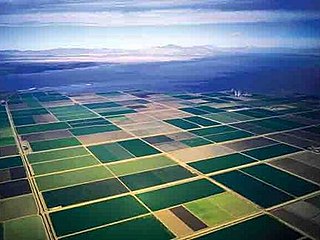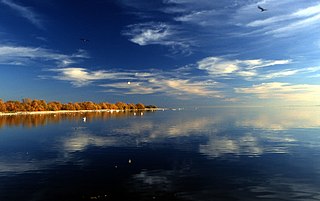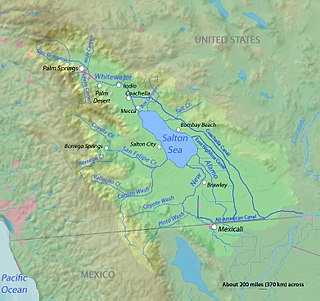
Imperial County is a county located on the southeast border of the U.S. state of California. As of the 2020 census, the population was 179,702, making it the least populous county in Southern California. The county seat and largest city is El Centro. Imperial is the most recent California county to be established, as it was created in 1907 out of portions of San Diego County.

The Salton Sea is a shallow, landlocked, highly saline body of water in Riverside and Imperial counties at the southern end of the U.S. state of California. It lies on the San Andreas Fault within the Salton Trough, which stretches to the Gulf of California in Mexico.

The Imperial Valley of Southern California lies in Imperial and Riverside counties, with an urban area centered on the city of El Centro. The Valley is bordered by the Colorado River to the east and, in part, the Salton Sea to the west. Farther west lies the San Diego and Imperial County border. To the north is the Coachella Valley region of Riverside County, which together with Imperial Valley form the Salton Trough, or the Cahuilla Basin, also the county line of Imperial and Riverside counties, and to the south the international boundary with Mexico.

The Low Desert is a common name for any desert in California that is under 2,000 feet in altitude. These areas include, but are not exclusive to, the Colorado Desert and Yuha Desert, in the Southern California portion of the Sonoran Desert. These areas are distinguished in biogeography from the adjacent northern High Desert or Mojave Desert by latitude, elevation, animal life, climate, and native plant communities.

California's Colorado Desert is a part of the larger Sonoran Desert. It encompasses approximately 7 million acres, including the heavily irrigated Coachella and Imperial valleys. It is home to many unique flora and fauna.

The All-American Canal is an 82-mile (132 km) long aqueduct, located in southeastern California. It conveys water from the Colorado River into the Yuma Project, the Imperial Valley, and to nine cities. It is the Imperial Valley's only water source, and replaced the Alamo Canal, which was located mostly in Mexico. The Imperial Dam, about 30 miles (48 km) northeast of Yuma, Arizona on the Colorado River, diverts water into the All-American Canal, which runs to just west of Calexico, California before its last branch heads mostly north into the Imperial Valley. Smaller canals branching off the All-American Canal move water into the Yuma Valley and the Imperial Valley. These canal systems irrigate up to 630,000 acres (250,000 ha) of crop land and have made possible a greatly increased crop yield in this area, originally one of the driest on earth. It is the largest irrigation canal in the world, carrying a maximum of 26,155 cubic feet per second (740.6 m3/s). Agricultural runoff from the All-American Canal drains into the Salton Sea.

The Salton Sink is the low point of an endorheic basin, a closed drainage system with no outflows to other bodies of water, in the Colorado Desert sub-region of the Sonoran Desert. The sink falls within the larger Salton Trough and separates the Coachella Valley from the Imperial Valley, which are also segments of the Salton Trough. The lowest point of the sink is 269 ft (82 m) below sea level, and since 1906 the 343 square miles (890 km2) Salton Sea has filled the lowest portion of the sink to a water depth of up to 43 ft (13 m).

The Alamo River flows west and north from the Mexicali Valley across the Imperial Valley (California). The 52-mile-long (84 km) river drains into the Salton Sea.

The New River flows north from near Cerro Prieto, through the city of Mexicali, Baja California, Mexico, into the United States through the city of Calexico, California, towards the Salton Sea. The river channel has existed since pre-historic times. The river as known today formed from a levee failure and massive flooding that filled the Salton Sea.
The California Development Company was formed in 1896 as a replacement for the defunct Colorado River Irrigation Company, which had been started a few years earlier for the purpose of planning an irrigation system for the lower Colorado Desert in California. The rich, silty soil of the area was found to be suitable for agriculture, but wells tapping groundwater brought up an inadequate supply of water for such a hot, arid region. The California Development Company took over the project of diverting Colorado River water into the Coachella and Imperial Valleys in the Salton Sink, a dry lake bed which today contains the Salton Sea, hoping to turn the desert green with agricultural fields. The first canals were being constructed by 1900 under the guidance of chief engineer George Chaffey.
The Imperial Irrigation District (IID) is an irrigation district that serves the Imperial Valley in Southern California. Established under the State Water Code, the IID supplies roughly 500,000 acres (200,000 ha) of Imperial Valley farmland with raw Colorado River water to support irrigation. In addition to providing irrigation, IID also supplies electrical energy to the valley.
The Imperial Land Company was a land colonization company incorporated in California in March, 1900 for the purpose of encouraging settlement of the Imperial Valley thus providing customers for the California Development Company. Imperial Land was formed by George Chaffey and several other individuals associated with the California Development Company.

Harry Thomas Cory was an American engineer and professor.

The Sonny Bono Salton Sea National Wildlife Refuge is located in the Imperial Valley of California, 40 miles (64 km) north of the Mexican border. Situated at the southern end of the Salton Sea, the refuge protects one of the most important nesting sites and stopovers along the Pacific Flyway. Despite its location in the Colorado Desert, a subdivision of the larger Sonoran Desert, the refuge contains marine, freshwater, wetland, and agricultural habitats which provide sanctuary for hundreds of birds and wetland species, including several that have been listed as endangered or sensitive by the U.S. Fish and Wildlife Service.

Oliver M. Wozencraft was a prominent early American settler in California. He had substantial involvement in negotiating treaties between California Native American Indian tribes and the United States of America. Later, Wozencraft promoted a plan to provide irrigation to the Imperial Valley.

The Alamo Canal was a 14 mi (23 km) long waterway that connected the Colorado River to the head of the Alamo River. The canal was constructed to provide irrigation to the Imperial Valley. A small portion of the canal was located in the United States but the majority of the canal was located in Mexico. The Alamo Canal is also known as the Imperial Canal.
The Colorado River Irrigation Company was incorporated in Colorado on January 7, 1892 for the purpose of irrigating "lands contiguous to the Colorado River." The company founders claimed to be able to irrigate 3,000,000 acres (12,000 km2), with 1,000,000 acres (4,000 km2) of that being in San Diego County, California and the remainder in Baja California, Mexico. They projected that the canal would be completed within two years. The Colorado River was described as an "inexhaustible source."

The Salton Trough is an active tectonic pull-apart basin, or graben. It lies within the Imperial, Riverside, and San Diego counties of southeastern California and extends south of the Mexico–United States border into the state of Baja California.

Eduardo Garcia is an American politician who represents the 56th Assembly District, which includes cities and unincorporated communities in eastern Riverside County and Imperial County, including Blythe, California, Brawley, California, Bermuda Dunes, Calexico, California, Calipatria, Cathedral City, California, Coachella, California, Desert Hot Springs, El Centro, Heber, Holtville, Imperial, Indio, California, Mecca, California, Oasis, North Shore, California, Salton City, California, Thermal, California, Thousand Palms, and Westmorland, California.

Lake Cahuilla was a prehistoric lake in California and northern Mexico. Located in the Coachella and Imperial valleys, it covered surface areas of 5,700 km2 (2,200 sq mi) to a height of 12 m (39 ft) above sea level during the Holocene. During earlier stages of the Pleistocene, the lake reached even higher elevations, up to 31–52 m (102–171 ft) above sea level. During the Holocene most of the water came from the Colorado River with little contribution from local runoff; in the Pleistocene local runoff was higher and it is possible that Lake Cahuilla was supported solely from local water sources during the Wisconsin glaciation. The lake overflowed close to Cerro Prieto into the Rio Hardy, eventually draining into the Gulf of California.


















